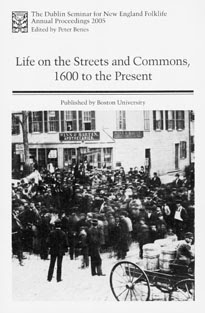Life on the Streets and Commons Now Available
 The latest volume of articles from the Dublin Seminar for New England Folklife, about life in public spaces, is now available. It includes my essay, “‘I never used to go out with a weapon’: Law Enforcement on the Streets of Prerevolutionary Boston.”
The latest volume of articles from the Dublin Seminar for New England Folklife, about life in public spaces, is now available. It includes my essay, “‘I never used to go out with a weapon’: Law Enforcement on the Streets of Prerevolutionary Boston.”
This paper focuses on the experiences of Benjamin Burdick, Jr., who was Constable of the Town House Watch in 1770. That means he was in charge of a four-man squad that patrolled the center of town at night. This post quoted a document spelling out the duties of a Constable of the Watch. (I owe Prof. Cornelia Hughes Dayton a special thanks for pointing me to the file of such town documents in the Boston Public Library.)
Historians have long known that Burdick was present at the Boston Massacre. He testified for the town’s report on the event and at the trials that followed. But people didn’t realize that he was on the scene as the closest thing Boston then had to a police officer; they thought he was just another man in the crowd.
Burdick testified that he brought “a Highland broadsword” to King Street on 5 Mar 1770, and some people have interpreted that to mean he was looking for a fight. He also described pushing to the front of the crowd, giving warnings to the soldiers and Crispus Attucks, fetching men to carry away the bodies after the shooting, and trying to memorize the shooters’ faces—basically, thrusting himself forward all the time.
Once I spotted Burdick’s name in town records related to the watchmen, I realized that all his actions made sense as part of his law-enforcement duties. Even carrying the sword wasn’t surprising since watchmen had had several confrontations and fights with army officers between October 1768 and March 1770. Burdick’s testimony that “I never used to go out with a weapon” showed how much he thought Boston had changed after army regiments were stationed there.
In the article I also discuss Edward Langford, a watchman who reported to Burdick; why British army officers had more recorded confrontations with watchmen than enlisted men; and the ups and downs of the town watch system. This research eventually led me to the story of Pvt. John Moies, which didn’t make it into the paper.
The other articles in Life on the Streets and Commons cover a wide range of periods and places in New England culture, from the Shaker communities to the Big E in Springfield.

2 comments:
Interesting to see "the massacre" from a perspective more in-line with the enraged colonists. Most historians take a more logical view, though by logical view I mean only that when so many assaults have occurred and enough ice and rock have flown at a few by the hands of many, eventually a gun will go off.
It’s notable that in the ten-year period before April 1775, British government employees killed six people in Boston, but people in Boston killed zero government employees or supporters.
The town’s resistance to the Crown was violent at times, and included physical assaults on people. Yet those assaults were never fatal.
To some extent that was luck (Samuel Dyer certainly tried to kill the artillery officers he met in October 1774). But I think it also reflected the numbers on each side.
At most times, the people who opposed new Crown measures vastly outnumbered those who enforced or supported them. That means the Whigs/Patriots came in crowds, and rarely needed to pull out fatal weapons. On the other side, the friends of government felt isolated and threatened, and thus were quicker to resort to using guns.
Post a Comment